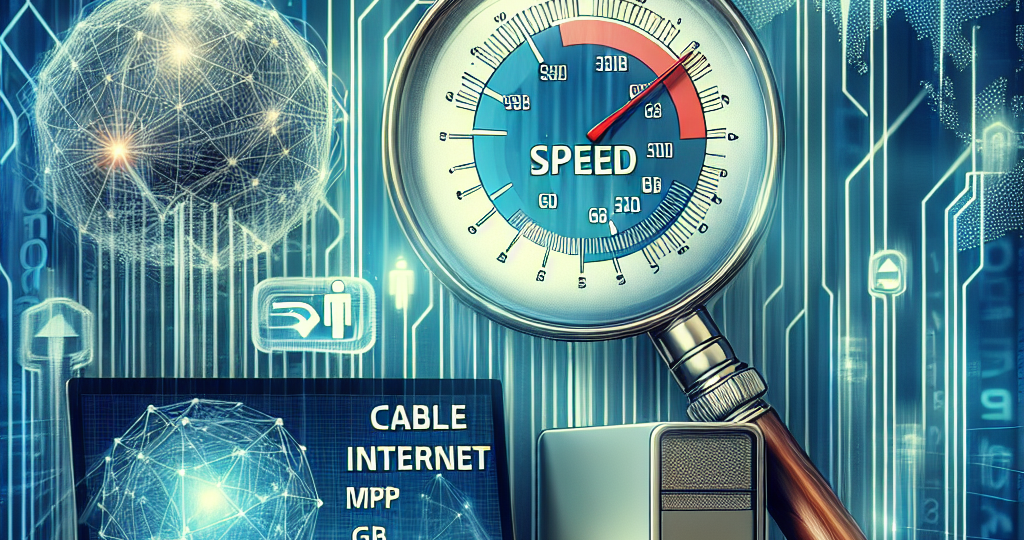Exploring Cable Internet Speed Options: A Comprehensive Analysis
September 12, 2024 | by Javier Linn

In today’s fast-paced digital age, having a reliable and lightning-fast internet connection is essential. When it comes to cable internet, there are a plethora of speed options available that can greatly impact your online experience. From blazing speeds that allow for seamless streaming and gaming, to more budget-friendly options that still deliver reliable browsing capabilities, the choices can be overwhelming. In this comprehensive analysis, we will delve into the world of cable internet speed options, comparing and contrasting different packages to help you find the perfect fit for your needs. Join us as we explore the world of cable internet speeds and unlock the key to a smoother online experience.
Understanding Cable Internet Speeds
- Types of cable internet speeds
Cable internet speeds typically fall into three main categories: basic, mid-tier, and high-speed packages. These packages offer varying rates of data transmission, measured in megabits per second (Mbps). Basic packages usually provide speeds ranging from 25 Mbps to 100 Mbps, suitable for light internet users who engage in activities like browsing, checking emails, and light streaming. Mid-tier packages offer speeds between 100 Mbps and 300 Mbps, catering to households with multiple users who engage in moderate to heavy internet usage, such as HD streaming and online gaming. High-speed packages deliver speeds of 300 Mbps and above, ideal for power users, gamers, and households with multiple devices simultaneously streaming high-definition content or engaging in bandwidth-intensive activities like video conferencing or large file downloads.
- Basic packages
Basic cable internet packages are designed for individuals or small households with minimal internet usage requirements. These packages typically offer speeds ranging from 25 Mbps to 100 Mbps, which are sufficient for activities like browsing the web, checking emails, and occasional video streaming. Basic packages are budget-friendly options that provide reliable internet connectivity for light users without the need for high-speed performance.
- Mid-tier packages
Mid-tier cable internet packages cater to households with multiple users and devices that engage in more demanding online activities. With speeds ranging from 100 Mbps to 300 Mbps, mid-tier packages offer faster data transmission rates that support HD streaming, online gaming, video conferencing, and simultaneous device usage. These packages are suitable for moderate to heavy internet users who require a balance between performance and affordability.
- High-speed packages
High-speed cable internet packages are tailored for power users, gamers, and households with extensive internet usage needs. Offering speeds of 300 Mbps and above, high-speed packages deliver optimal performance for bandwidth-intensive activities like 4K streaming, online gaming with low latency, video conferencing with high-quality video, and large file downloads. These packages provide the fastest data transmission rates available through cable internet technology, ensuring a seamless online experience for users with demanding connectivity requirements.
Factors Influencing Internet Speeds

Bandwidth Allocation
Bandwidth allocation plays a critical role in determining the internet speed experienced by users. It refers to the amount of data that can be transmitted in a given amount of time over the network connection. When multiple users are sharing the same network, the bandwidth is divided among them, impacting the speed each user receives. Internet Service Providers (ISPs) allocate different amounts of bandwidth to users based on their subscribed plans, affecting the overall speed potential.
Network Congestion
Network congestion occurs when the volume of data traffic surpasses the network’s capacity, resulting in slowdowns and decreased internet speeds for users. During peak hours or in densely populated areas, network congestion is more likely to happen, leading to reduced speeds and potential service interruptions. ISPs continuously monitor and manage network congestion to optimize performance and enhance user experience.
Hardware Capabilities
The hardware used by both the ISP and the end-user can significantly influence internet speeds. Routers, modems, cables, and other networking equipment need to support the desired speed levels to ensure a smooth and fast connection. Outdated or incompatible hardware may bottleneck the internet speed, limiting the data transfer rate and overall performance. Upgrading to modern, high-speed capable hardware can help users maximize their internet speed potential and improve their online experience.

Assessing Your Internet Needs
When considering cable internet speed options, it is crucial to begin by assessing your specific internet needs. This initial step will help you determine the most suitable speed tier that aligns with your usage patterns, ensuring optimal performance for your online activities. Here are key factors to consider:
-
Determining your usage patterns: Start by evaluating how you typically use the internet. Consider whether you primarily engage in basic browsing, email communication, and social media interactions, or if you frequently engage in bandwidth-intensive activities such as streaming high-definition videos, online gaming, or large file downloads. Understanding your usage patterns will provide insight into the level of speed required to support your online activities efficiently.
-
Identifying the number of connected devices: Take stock of the devices connected to your home network. In today’s interconnected world, households often have multiple devices simultaneously accessing the internet, including smartphones, tablets, laptops, smart TVs, gaming consoles, and smart home devices. The more devices connected at once, the greater the demand on your internet speed. Consider the number of devices in your household to ensure that your chosen cable internet speed can accommodate simultaneous connections without experiencing slowdowns or buffering issues.
-
Considering streaming and gaming requirements: If you frequently stream content on platforms like Netflix, Hulu, or YouTube, or engage in online gaming, you will likely require higher internet speeds to ensure smooth playback, minimal buffering, and low latency. Streaming high-definition content and participating in online gaming sessions demand a stable and fast connection to deliver an optimal user experience. Assess your streaming and gaming habits to determine the speed necessary to support these activities without interruptions or lag.
By carefully assessing your internet needs based on your usage patterns, the number of connected devices in your household, and your streaming and gaming requirements, you can make an informed decision when exploring cable internet speed options. This proactive approach will help you select a speed tier that meets your specific requirements, enhancing your overall internet experience.
Comparing Speed Options from Different Providers
When comparing speed options from different cable internet providers, it is crucial to conduct thorough research to make an informed decision based on your specific needs and budget. Here are the key factors to consider:
-
Researching available plans: Begin by exploring the websites of various cable internet providers to gather information on the packages they offer. Look for details on the speed tiers available, any data caps or throttling policies, and whether they offer standalone internet or bundle options.
-
Analyzing upload and download speeds: One of the most critical aspects of comparing cable internet plans is the speed they offer. Pay close attention to both upload and download speeds, as they can significantly impact your online experience, especially if you engage in activities like video conferencing, gaming, or large file transfers.

– Evaluating promotional offers and discounts: Many cable internet providers offer promotional deals and discounts to attract new customers. Take the time to assess these offers carefully, keeping in mind that introductory rates may increase after a certain period. Factor in the overall cost over time to determine the best value for your money.
Enhancing Speed Performance
Enhancing the speed performance of your cable internet connection can significantly improve your online experience. By implementing the following strategies, you can optimize your internet speed and ensure smoother browsing, streaming, and online gaming experiences.
-
Upgrading to a higher speed tier: One of the most straightforward ways to enhance your internet speed is by upgrading to a higher speed tier offered by your internet service provider (ISP). Higher-speed tiers typically offer faster download and upload speeds, which can result in quicker webpage loading times, smoother video streaming, and reduced latency during online gaming sessions.
-
Optimizing router settings: Another effective way to boost your internet speed is by optimizing your router settings. Adjusting settings such as the channel width, frequency band, and Quality of Service (QoS) parameters can help maximize the efficiency of your wireless connection and ensure a stable, high-speed connection throughout your home or office.
-
Using Ethernet connections for stable speeds: While Wi-Fi is convenient, using Ethernet connections can provide even greater speed and stability. Connecting your device directly to the router via an Ethernet cable can eliminate potential interference and signal degradation associated with wireless connections, resulting in faster and more reliable internet speeds for bandwidth-intensive activities like video conferencing or large file downloads.
Resolving Common Speed Issues
When faced with slow internet connections, it is crucial to address the issue promptly to ensure a seamless browsing experience. Here are some effective strategies to troubleshoot and resolve common speed issues:
- Troubleshooting Slow Internet Connections
Slow internet connections can be caused by various factors such as network congestion, signal interference, or outdated equipment. Conducting a thorough troubleshooting process can help pinpoint the root cause of the speed issue. Start by checking the physical connections of your modem and router to ensure everything is properly connected. Additionally, running a speed test using online tools can provide valuable insights into your current download and upload speeds.
- Checking for Software Updates
Outdated software can significantly impact internet speed and performance. Make sure to regularly check for software updates on your devices, including your computer, modem, and router. Updating to the latest firmware can help optimize network settings and improve overall connectivity.
- Restarting the Router
A simple yet effective solution to resolve speed issues is to restart your router. Power cycling the router by unplugging it from the power source for a few seconds and then plugging it back in can help refresh the connection and eliminate any temporary glitches that may be affecting speed.
- Contacting Customer Support for Assistance
If all troubleshooting steps fail to improve your internet speed, reaching out to your internet service provider’s customer support team can provide additional assistance. They can conduct remote diagnostics, identify any network issues on their end, or schedule a technician visit to further investigate and resolve the speed problems. Customer support is a valuable resource for resolving complex speed issues and ensuring a reliable internet connection.
FAQs Exploring Cable Internet Speed Options: A Comprehensive Analysis
What factors should I consider when choosing a cable internet speed option?
When choosing a cable internet speed option, you should consider your household’s internet usage habits, the number of devices connected to the network, the type of online activities you engage in, and your budget. It is important to strike a balance between choosing a speed that meets your requirements without overpaying for unnecessary bandwidth.
What are the common cable internet speed options available to consumers?
Common cable internet speed options available to consumers include packages ranging from 25 Mbps to 1 Gbps (Gigabit per second). These speeds are typically categorized as basic, standard, and high-speed plans, with each offering varying levels of download and upload speeds to cater to different user needs.
How do I know which cable internet speed option is right for me?
To determine the right cable internet speed option for your household, consider factors such as the number of users, the types of online activities (e.g., streaming, gaming, etc.), and the demand for high-speed connectivity. Conducting a speed test can also help gauge your current internet performance and identify any potential bottlenecks.
What are the benefits of opting for a higher cable internet speed option?
Opting for a higher cable internet speed option can offer faster download and upload speeds, reduced latency, smoother video streaming, and improved online gaming experiences. Additionally, higher speeds can accommodate multiple devices connecting to the network simultaneously, resulting in a more seamless internet browsing experience.
Can I upgrade or downgrade my cable internet speed option after signing up for a plan?
Most cable internet service providers offer the flexibility to upgrade or downgrade your internet speed option after signing up for a plan. However, keep in mind that changes in speed options may come with corresponding changes in monthly subscription fees. It is advisable to check with your provider for specific terms and conditions regarding speed upgrades or downgrades.
Double your Internet Speed by changing 1 thing on your Smart TV!
RELATED POSTS
View all

